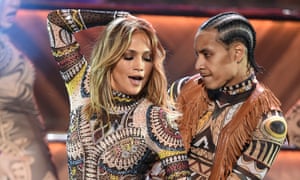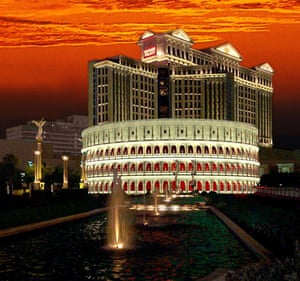On Wednesday, J Lo follows Britney Spears and Mariah Carey to start her own residency in Sin City. It’s a sign of how entertainment there has changed – thanks to a younger demographic who no longer just want to play the slots

Jennifer Lopez at the American Music Awards: Vegas show is set to be a spectacle. Photograph: Kevin Winter/Getty Images
Where once Vegas was seen as a well-lit retirement home for ageing crooners, the move towards younger, more pop-focused artists, as well as a slew of EDM DJs taking up residence in the handful of superclubs, has helped not only lower the average age of its clientele but make up for the shortfall in gambling profits (gaming revenue dropped 2.5% last year, despite a record-breaking 42.3 million visitors). With professional rap goon Pitbull due to start the second of his so-called mini-residencies in March, it’s clear the big casinos aren’t just focusing on the grey pound any more.
The Vegas residency as lavish spectacle was first put on the map by shrinking violet Liberace, who made his Vegas debut in 1944 and allegedly earned $300,000 a week for his shows in the 1970s and 80s. His debut was followed by the likes of the Rat Pack and Elvis Presley.

Caesars Palace, where stars including Celine Dion and Mariah Carey performed. Photograph: AP
Over time, however, Vegas’s entertainment options became clogged with a mix of heritage acts looking to see out the remainder of their careers and risk-free spin-off shows. “Vegas tends to go through eras of entertainment,” explains Sarah Feldberg, former editor-in-chief of the Las Vegas Weekly. “There was a Cirque de Soleil era, where every casino wanted a show like that. There was a Broadway era where we were putting on shows like The Lion King, but now those are falling to the side and being replaced by headliners in a big way.” The catalyst for this change, Feldberg argues, was Celine Dion, whose 2003 residency A New Day grossed over $400m in four years. “She really proved that a Vegas residency could be really successful and really profitable in this era.”
So while a Celine Dion show is hardly comparable to a Jennifer Lopez show, A New Day’s success sent a clear message to established pop stars: instead of schlepping around the country (or the world) you could stay put in one city, live in a nice big mansion nearby with your family, and put on a show that wasn’t restricted by what could fit in a truck (Shania Twain’s 2012 residencyfeatured her singing You’re Still The One on horseback, for example).
Britney’s recent world tours have been blighted by the fact that she didn’t really seem to want to do them – but the consistency of life in Vegas seems to have rejuvenated her. The flexibility also allows her to take time off to record new material (she’s currently working on her ninth album), with a view to performing those new songs live as and when. “I think the stereotype for a long time was that people who performed and had resident shows in Vegas were once great performers who were past their prime and were there as a nostalgia act, ie people not making relevant new music,” Feldberg says. “I think that has changed now.”
Over time, however, Vegas’s entertainment options became clogged with a mix of heritage acts looking to see out the remainder of their careers and risk-free spin-off shows. “Vegas tends to go through eras of entertainment,” explains Sarah Feldberg, former editor-in-chief of the Las Vegas Weekly. “There was a Cirque de Soleil era, where every casino wanted a show like that. There was a Broadway era where we were putting on shows like The Lion King, but now those are falling to the side and being replaced by headliners in a big way.” The catalyst for this change, Feldberg argues, was Celine Dion, whose 2003 residency A New Day grossed over $400m in four years. “She really proved that a Vegas residency could be really successful and really profitable in this era.”
So while a Celine Dion show is hardly comparable to a Jennifer Lopez show, A New Day’s success sent a clear message to established pop stars: instead of schlepping around the country (or the world) you could stay put in one city, live in a nice big mansion nearby with your family, and put on a show that wasn’t restricted by what could fit in a truck (Shania Twain’s 2012 residencyfeatured her singing You’re Still The One on horseback, for example).
Britney’s recent world tours have been blighted by the fact that she didn’t really seem to want to do them – but the consistency of life in Vegas seems to have rejuvenated her. The flexibility also allows her to take time off to record new material (she’s currently working on her ninth album), with a view to performing those new songs live as and when. “I think the stereotype for a long time was that people who performed and had resident shows in Vegas were once great performers who were past their prime and were there as a nostalgia act, ie people not making relevant new music,” Feldberg says. “I think that has changed now.”
It’s also no coincidence that Britney, Mariah and now J Lo all had the majority of their successes in the 90s and early 00s. While this new batch of residencies are all aimed at a younger audience than, say, Elton John’s, it’s still a balancing act. “The people who book for these venues know who the Vegas visitor is, and the people spending money and coming to Vegas are not 18 years old because they can’t gamble,” Feldberg explains. “It really is a 21-plus town, so the people with expendable income are people who have been in the workforce for a little while and they have the income to come and get a ticket for one of these shows. They want an artist who they know is going to appeal to multiple generations or a wider swath of people. It’s also worth noting that J Lo, Britney Spears and Pitbull are all playing at the Planet Hollywood and that’s a strategic choice by Caesars Entertainment to put the younger-skewing, more party-ready artists in a place that caters for younger guests.

Britney Spears in Vegas: abs-olutely lucrative. Photograph: Denise Truscello/Associated Press
Running parallel with the move towards the more pop-orientated residencies is the rise of Vegas’s obsession with the EDM DJ. Kent Otto, founder and editor-in-chief of Electronic.Vegas, cites Paul Oakenfold’s 2008 residency at Palms’ Rain nightclub as a turning point, with Las Vegas reflecting America’s newfound love for dance music. “The rise of EDM has definitely breathed new life into the city, making the destination appealing to younger tourists who have little interest in gaming but still want the “Vegas” experience,” Otto says. “It’s also a value proposition for visitors – you can drop $100 on a few hands of blackjack in a matter of minutes or head to a nightclub and spend several hours soaking in the experience.” Otto also thinks the boom in social media played its part, with people able to share memories of their all-nighters in Sin City. “Let’s be honest, there are only so many selfies one can take at a slot machine.”
Where residencies in the past were often loss-leaders, with casinos banking on people spending money on gambling before and after, the modern-day residency is a huge part of Vegas’s broader appeal away from the blackjack tables. “Where else can you see a Britney performance, eat at a fancy buffet or celebrity chef restaurant, party at a day-club with Calvin Harris and spend a night at [MGM Grand’s superclub] Hakkasan with Tiesto all in one weekend?” Otto says. “You can’t do that in Ibiza. You can’t do that anywhere else with the same ease and convenience as Vegas.”
Running parallel with the move towards the more pop-orientated residencies is the rise of Vegas’s obsession with the EDM DJ. Kent Otto, founder and editor-in-chief of Electronic.Vegas, cites Paul Oakenfold’s 2008 residency at Palms’ Rain nightclub as a turning point, with Las Vegas reflecting America’s newfound love for dance music. “The rise of EDM has definitely breathed new life into the city, making the destination appealing to younger tourists who have little interest in gaming but still want the “Vegas” experience,” Otto says. “It’s also a value proposition for visitors – you can drop $100 on a few hands of blackjack in a matter of minutes or head to a nightclub and spend several hours soaking in the experience.” Otto also thinks the boom in social media played its part, with people able to share memories of their all-nighters in Sin City. “Let’s be honest, there are only so many selfies one can take at a slot machine.”
Where residencies in the past were often loss-leaders, with casinos banking on people spending money on gambling before and after, the modern-day residency is a huge part of Vegas’s broader appeal away from the blackjack tables. “Where else can you see a Britney performance, eat at a fancy buffet or celebrity chef restaurant, party at a day-club with Calvin Harris and spend a night at [MGM Grand’s superclub] Hakkasan with Tiesto all in one weekend?” Otto says. “You can’t do that in Ibiza. You can’t do that anywhere else with the same ease and convenience as Vegas.”

Calvin Harris: currently in year two of a three-year Vegas deal. Photograph: John Lamparski/WireImage
Just as Celine Dion’s initial success lured in slightly older acts like Cher and Shania Twain, the rise of the EDM DJ has made it easier and less risky for more dance-orientated pop stars such as Britney and J Lo to take up residency. For Otto it’s a case of pop stars not only following a successful model laid out by Dion, but now also “knowing their target audience is already visiting and ready to spend money on unique experiences. Of course selling a Britney ticket to this [dance music] crowd is a much more logical proposition than trying to lure one to Celine or Elton.”
While Otto is convinced the superstar DJ bubble will burst, chiefly because the salaries are sky-rocketing (“Nightclubs lose talent to other competitors in town all the time because they just can’t keep up with the demands”), Feldberg thinks that clever scheduling could help avoid oversaturation of the pop residencies. “There is the possibility of reaching a peak but one thing that helps the residency concept is that, unlike a Cirque show, J Lo’s only here a certain number of days; she’s not necessarily competing against Britney or Mariah.”
Feldberg also believes that as more artists from different genres and at different points in their career sign up (Bruno Mars had a mini-residency in 2013, just two albums into his career) it will encourage others to do the same. Somewhat surprisingly, it’s Pitbull who best represents the changing face of the Las Vegasstrip. “Fifteen years ago the idea of having a hip-hop or rap artist doing any kind of residency would have been unthinkable,” Feldberg says. Perhaps it won’t be too long before we see Kanye West in Vegas.






0 comments:
Post a Comment